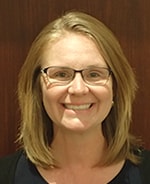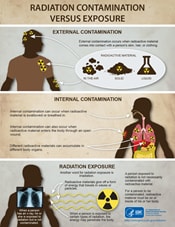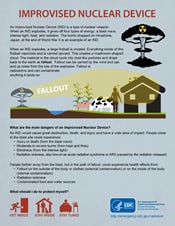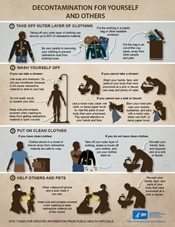

Title: Physical Scientist, Radiation Studies Section, Emergency Management, Radiation, and Chemical Branch, CDC’s National Center for Environmental Health
Education: BS, Chemistry; MS, Health Physics
Public Health Law News (PHLN):Please describe your career path and what drew you to public health and management of radiological emergencies in particular.
Buzzell:I never imagined working in public health or in the radiation field, for that matter. I loved science and thought a position in a laboratory would be right up my alley. After I earned my degree in chemistry from Kennesaw State University in suburban Atlanta, I applied for laboratory positions as well as middle and high school teaching positions. I ran into a former professor while picking up my transcripts on campus, and she mentioned Oak Ridge Institute for Science and Education (ORISE) fellowships. I applied and began my career here at CDC in the Inorganic Toxicology group within the Division of Laboratory Sciences of the National Center for Environmental Health in 2000. After 9/11, I was asked to build the radiation capabilities for the laboratory. Knowing I needed more knowledge of radiation, I pursued my masters in health physics. In 2008, I moved over to the Radiation Studies Branch (now Section) in a health physics capacity.
PHLN:What role does CDC, specifically the Emergency Management, Radiation, and Chemical Branch, play in responding to radiological emergencies?
Buzzell:In response to a radiological emergency, our branch will—
- Provide subject matter expertise and technical assistance to our state and local public health partners
- Represent CDC on the federal Advisory Team for Environment, Food, and Health, which provides technical advice and recommendations to the coordinating federal agency or affected jurisdictions (other agencies represented include EPA, FDA, and USDA)
- Assess radiation doses of affected people
- Staff the CDC Emergency Operations Center
- Communicate health and safety messages to various audiences, including other federal agencies, state and local partners, the public, and the media
Additionally, other CDC centers, institutes, and offices will provide subject matter expertise to support the response. Examples of expert topic areas are vulnerable populations and communications.
PHLN:What is radiation, and what happens when someone is exposed to it?
Buzzell:Radiation is energy moving in the form of particles or waves. Familiar radiations are heat, light, radio waves, and microwaves. Radiation can be categorized into ionizing and nonionizing. Ionizing radiation is a very high-energy form of electromagnetic radiation and is the one we focus on in an emergency.
When significant amounts of radioactive material are dispersed, a person may become contaminated or exposed to it. A person can be externally contaminated, internally contaminated, and/or exposed to radioactive materials. External contaminationoccurs when radioactive material comes in contact with a person’s skin, hair, or clothing. A relatable example of external contamination is like mud or dirt in your hair and on your clothes.Internal contaminationoccurs when radioactive material is swallowed or breathed in, or it enters the body through an open wound. When a person is exposedto ionizing radiation, the energy penetrates the body. An x-ray is an example of exposure to ionizing radiation. The radiation penetrates your body, so you are exposed but not contaminated.
When someone is contaminated or exposed to ionizing radiation, DNA may be damaged. The DNA may be repaired by the body depending on the amount of radiation the individual was exposed to.
PHLN:How might individuals be exposed to radiation? Are some situations more likely than others?
Buzzell:We are all exposed to radiation daily from naturally occurring radioactivity in our environment. For more information about radiation in your life, please visit www.cdc.gov/nceh/radiation/sources.html#nature.
Individuals may also be exposed to radiation when there is a radiation emergency—for example, when an improvised nuclear device is detonated. This scenario would be similar to the bombs used during World War II in Japan. Also, individuals may be externally contaminated if radioactive materials fell on them. Generally, about 70%–90% of external contamination can be removed by taking off the outer layer of clothing. The remaining contamination may be removed by washing the skin that was not covered with clothes in warm soapy water.
PHLN:You recently co-authored a paper discussing legal language authorizing states to respond to radiological incidents. What did you find?
Buzzell:Yes, Gabriella Klaes, a former ORISE fellow with CDC’s Public Health Law Program, surveyed the legal language of the states, as well as three cities, to understand what authority, if any, the states and cities possessed to decontaminate or restrict the movement of individuals after a radiation emergency. The language fell into four categories: express, broad, narrow, and limited to biologics (see table below for descriptions and examples). Also, the category may change if an emergency is declared. For example, if a jurisdiction needed to decontaminate individuals presenting with radiological contamination and an emergency was not declared, only 15 percent of jurisdictions had express language addressing how to proceed. Almost half (49 percent) used broad provisions that were not expressly about radiation, four percent had a narrow definition of radiation, and 32 percent of jurisdictions limited their decontamination laws to biologics. Language differences may impact the legal and tactical approaches adjacent jurisdictions use when responding to a radiological incident.
| State/Local Category | Description of Category |
|---|---|
| Express Language | Language to restrict the movement of or decontaminate persons with radiological contamination. The provisions include terms such as “radiation” or “radiological agents.” Example: “The local health officer may issue, and first responders may execute, an order authorizing first responders to immediately isolate exposed individuals that may have been exposed to biological, chemical, toxic, or radiological agents that may spread to others.”i |
| Broad Language | Language to restrict the movement of or decontaminate persons that is neither expressly linked to radiological agents nor limited to biologics. The provisions include language such as “threat to public health” or “hazards to health.” Example: “The department may quarantine or isolate individuals who have been exposed to hazardous materials that can cause serious illness or injury by transmission of the hazardous material to others.”ii |
| Narrow Language | Language to restrict the movement of or decontaminate persons based on a particular condition or type of radiological release. The provisions include language referring only to terrorist attacks or incidents involving nuclear agents. Example: “If the State Health Director reasonably suspects that a public health threat may exist and that the threat may have been caused by a terrorist incident using nuclear, biological, or chemical agents, the State Health Director is authorized to order any of the following: . . . Limit the freedom of movement or action of a person or animal that is contaminated with, or reasonably suspected of being contaminated with, a biological, chemical or nuclear agent that may be conveyed to other persons or animals.”iii |
| Limited to Biologic Language | Language to restrict the movement of or decontaminate persons is limited to biologics through terms pertaining only to communicable and infectious diseases; there is no language regarding radiation. Example: “A health officer or the Department, upon receiving a report of a communicable disease, shall, by written order, establish such isolation or quarantine measures as medically and epidemiologically necessary to prevent or control the spread of the disease.”iv |
PHLN:What kind of jurisdictions should include radiological emergency preparedness in their emergency response planning and authorities?
Buzzell:Unless a jurisdiction has a nuclear power plant, radiological emergencies might not be identified as a risk in jurisdictional risk assessments. In October 2016, an update to the Nuclear/Radiological Incident Annex of the federal interagency operational plan was released. It says that state and local officials retain primary responsibility for public monitoring, screening, and decontamination operations in a radiological emergency. For example—after Hurricane Katrina, residents were displaced to all 50 states, including Alaska and Hawaii. Planning assumptions indicate if an improvised nuclear device or radiological dispersal device were to cause an incident, public health systems should similarly expect displacement of a large population in need of public health services, including radiological screening and decontamination.
PHLN:What are the greatest legal barriers jurisdictions should consider when drafting preparedness plans for radiological emergencies?
Buzzell:I would speculate that the greatest barrier is in the multi-disciplinary nature of the preparedness for and response to a radiological emergency. The expertise of law enforcement, public health, radiation scientists, legal representatives, and other stakeholders is necessary in the planning stage. State and local jurisdictions should have a comprehensive conversation about their legal authorities with all stakeholders to support a successful response should a radiological incident occur.
PHLN:What are the next steps for your work?
Buzzell:My next steps are continue to inform partners of how to prepare for and respond to radiation emergencies, expand upon CDC’s communication efforts during all phases of a radiation emergency, and continue to address gaps in our agency preparedness plans.
PHLN:What would you be doing if you weren’t working in community health?
Buzzell:Hands down, I would be an astronaut. I love space exploration.
PHLN:Have you read any good books lately?
Buzzell:Unfortunately, no. Having a two year old lends itself to enjoying sleep and not books.
PHLN:Do you have any hobbies?
Buzzell:I love to bake, knit, and read. One day soon I’ll be getting back into these as well as finishing up my private pilot’s license.
PHLN:Is there anything else you’d like to add?
Buzzell:Radiological emergencies are survivable. Get inside, stay inside, stay tuned. You can read more about protecting yourself and your loved ones here: What To Do During a Radiation Emergency.
























.png)









No hay comentarios:
Publicar un comentario